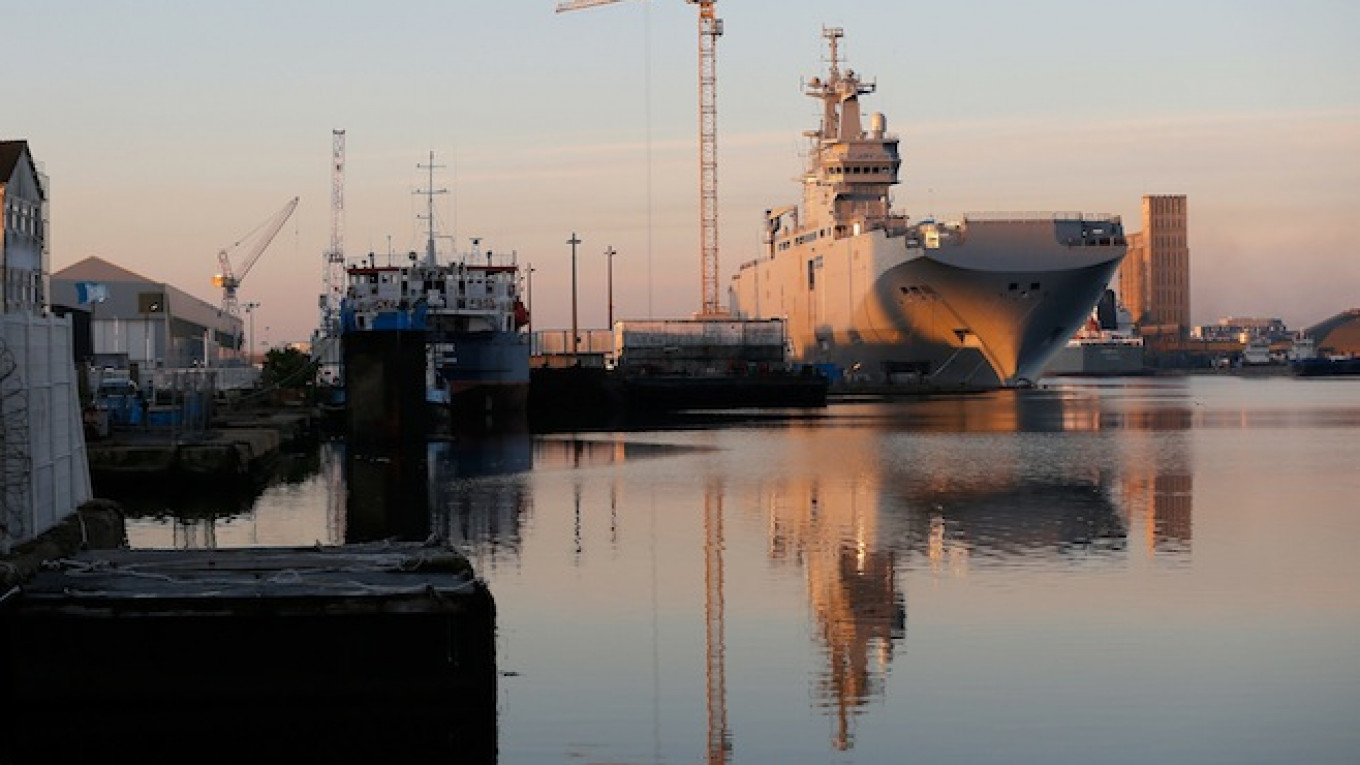France has agreed to reimburse Russia for the two Mistral-class helicopter carriers purchased under a 2011 contract, ending a months-long dispute over the fate of Russia's largest foreign arms purchase in the post-Soviet era.
But the question of whether Russia really needs such expensive ships other than for mere power projection is still dividing Russian officials and military analysts.
Russia paid 1.2 billion euros ($1.3 billion) for the ships, but the contract was suspended last year in response to Moscow's annexation of Crimea from Ukraine and subsequent support for pro-Russian separatists in eastern Ukraine.
French Defense Minister Jean-Yves Le Drian said Thursday that the money has been returned to Russia. President Vladimir Putin's spokesman Dmitry Peskov confirmed the news the same day.
The vessels were ordered by former Russian Defense Minister Anatoly Serdyukov in 2011 in what some observers described as a favor to France.
Admiral Vladimir Komoyedov, former commander of the Russian Black Sea Fleet, told the RIA Novosti news agency on Thursday that the purchase of the two French-built ships was a political decision rather than a military one.
"The decision to purchase the Mistrals was purely political, we didn't really need them. Our ships are better armed, and ships of the Mistral-class could only have been used in the Far East, where there is open access to the ocean — such as in the area around the Kuril Islands," said Komoyedov, who is now head of the State Duma's defense committee.
What Next?
Deputy Prime Minister Dmitry Rogozin, who oversees the defense industry, has repeatedly said during the past year that Russia was capable of building its own ships similar to the Mistral.
The Soviet Union built several types of smaller ships that were considered to be helicopter carriers, but they were only capable of carrying a handful of helicopters and were designed to assist the fleet in hunting U.S. submarines.
Now Russian naval design bureaus such as the esteemed Krylov State Research Center in St. Petersburg, perhaps hoping to see some of the refunded Mistral money thrown their way for a similar project, have been leaking their design proposals to the Russian media.
"Russian defense industry firms decided to join the party and have designed several original Russian projects in an effort to prove that they could also be reliable suppliers of helicopter carriers," said Vadim Kozyulin, a military expert at the Moscow-based PIR Center think tank.
In mid-June, an unidentified defense industry source told RIA Novosti about a Krylov helicopter carrier proposal known as the Lavina-class ship. The Lavina would be slightly larger than the 21,000-ton Mistrals, weighing in at 24,000 tons displacement.
Another proposal leaked to RIA Novosti came from the Nevsky Design Bureau, also in St. Petersburg. Nevsky's design, known as the Priboi-class helicopter carrier, would be smaller than the Mistrals, displacing a mere 14,000 tons of water, according to an unidentified defense industry source.
Unnecessary Burden?
While industry officials continue to argue over whether or not Russia should build its own versions of the Mistral, Russian defense analysts are divided over whether Russia needs such ships.
"The cancellation of the [Mistral] deal will be a real relief for the Russian defense budget and for the Russian navy," said Kozyulin.
"Helicopter carriers [like Mistral] are not armed and require huge air, anti-missile and anti-submarine defenses, which means they need to be escorted by a wide net of support vessels, and this is burdensome for any navy budget," Kozyulin said.
With Russia's economy in the doldrums, defense spending has been trimmed by 5 percent in 2015 to 3.1 trillion rubles ($48 billion) — forcing the Defense Ministry to choose between cutting procurements of new weapons, such as ships, or reducing spending on operations such as escorts for large vessels.
Even if Russia could afford to operate helicopter carriers, Kozyulin argued that they are more trouble than they are worth.
While naval planners found a Russia-specific mission for the oceangoing carriers — such as serving as command posts in small-scale conflicts such as the 2008 five-day war with Georgia — the operational sphere of such carriers is limited by the range of its helicopters.
This means that for the Mistral to be useful in an assault on enemy territory, it may have to approach the shore, which puts it in range of missiles, enemy aircraft, and even at risk of being shelled into the sea by enemy artillery.
However, former naval officer Maxim Shepovalenko, now an expert at the Center for the Analysis of Strategies and Technologies, argued that Russia needed the Mistral vessels, "not so much for Russia's standoff with NATO, but rather for the Pacific theater."
Russia cannot secure its strategic interests in the Pacific with its current force, Shepovalenko said, and the deployment of two Mistral-type ships to the Far East would give Russia a powerful asset to identify and deal with any intruders.
"As for escorts, these are already available, in particular Udaloi-class and Sovremenny-class destroyers from the Pacific Fleet, or nuclear or conventional submarines," he said.
One of the Mistrals, named Vladivostok, was supposed to be deployed in the Pacific. The other ship, the Sevastopol, was set to join the Pacific Fleet as well, but some Russian military officials suggested it might have eventually ended up in the Black Sea Fleet. However, port infrastructure for the two Mistral ships was only constructed in Vladivostok, indicating that Black Sea deployment was not on the cards in the short term.
Shepovalenko also noted Russia's recent naval doctrine update that prioritized the development of a blue-water, or oceangoing navy.
"Any navy with blue-water aspirations should have large aircraft-capable ships displacing over 20,000 tons," he said.
Russia only has one such ship, the Soviet-built Admiral Kuznetsov aircraft carrier, which is part of the Northern Fleet, which largely operates in the Atlantic and Arctic oceans.
"There is no "flattop" [aircraft carrier] in the Pacific, which is wrong. [Furthermore], the practical experience of running a large aircraft-carrying ship is, and should be, a key performance requirement for Russia's cadre of naval officers," Shepovalenko said.
Contact the author at m.bodner@imedia.ru
A Message from The Moscow Times:
Dear readers,
We are facing unprecedented challenges. Russia's Prosecutor General's Office has designated The Moscow Times as an "undesirable" organization, criminalizing our work and putting our staff at risk of prosecution. This follows our earlier unjust labeling as a "foreign agent."
These actions are direct attempts to silence independent journalism in Russia. The authorities claim our work "discredits the decisions of the Russian leadership." We see things differently: we strive to provide accurate, unbiased reporting on Russia.
We, the journalists of The Moscow Times, refuse to be silenced. But to continue our work, we need your help.
Your support, no matter how small, makes a world of difference. If you can, please support us monthly starting from just $2. It's quick to set up, and every contribution makes a significant impact.
By supporting The Moscow Times, you're defending open, independent journalism in the face of repression. Thank you for standing with us.
Remind me later.






